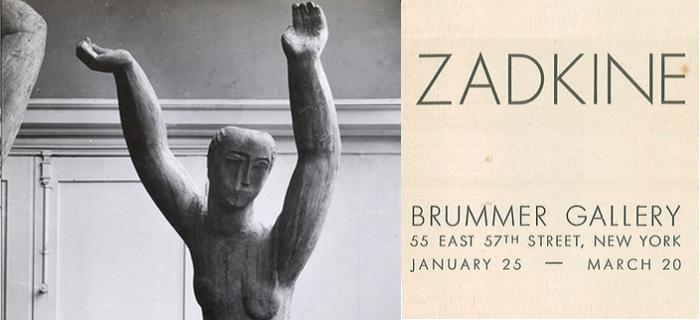DÉCOUVREZ LES 14 MUSÉES DE LA VILLE DE PARIS
Main menu

Joseph Brummer (1883-1947) was a Hungarian who arrived in Paris at the beginning of the twentieth century, and abandoned his career as a sculptor for the art trade. He opened a gallery on the Boulevard Raspail, specialising in African and Oceanian art and also introduced Le Douanier Rousseau. In 1914, he emigrated to America and opened a gallery in New York. As a major art dealer he supplied works to the greatest American collectors, Henry Walters, William Randolph Hearst and Bradley Martin. On his death, a large part of his collection was purchased by the Metropolitan Museum of Art. In the 1930s, he decided to exhibit European sculpture: Brancusi, Duchamp-Villon, Matisse, Gargallo and Lipchitz. In 1937, from 25th January to 20th March, he organised an exhibition devoted to Zadkine.
Zadkine went to New York for the first time to be present at the opening of his exhibition. “I was invited to make the trip. So for two weeks I was able to understand what the American art lover of the 1930s was like […] this American art lover was someone who had travelled and visited European museums. […] My exhibition opened American homes to me where modern artists were welcomed […] The hospitality was unlimited". The exhibition presented 33 sculptures (8 plaster, 4 wood, 6 stone, 12 bronze and 3 terracotta) and received excellent critical reviews. A catalogue was published including the list of works and texts by André de Ridder and Allan Ross Macdougall.
Zadkine provided the explanation for two monumental plaster works amongst those exhibited: “when the sculptures were too large, he [Joseph Brummer] had them moulded in plaster and transported in sections"
that of Homo sapiens (205 x 135 x 95 cm) which was purchased by the collector Bernard Davis, who then donated it to the Philadelphia Museum. The original in elm wood was acquired in 1947 by the Musée National d’Art Moderne.
that of Orpheus (295 x 100 x 76 cm) which was without doubt the copy given in 1953 by Zadkine to the Musée National d’Art Moderne. The original in elm wood was acquired in 1936 by the musée du Petit Palais, then transferred to the City of Paris Musée d’Art Moderne, on its inception.
Amongst the wooden sculptures:
The Odalisque in polychromd wood (which has belonged since 1953 to the collections of the Musée Réattu, in Arles)
Niobe, a figure already in the catalogue as belonging to the collection of Bernard Davis. This he donated in 1945 to the Philadelphia Museum of Art.
Homage to Bach (former collection of Willem Sandberg, who had received it as a gift from Zadkine, Stedelijk Museum, Amsterdam).